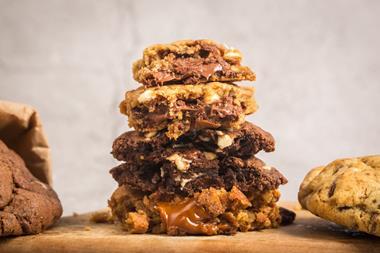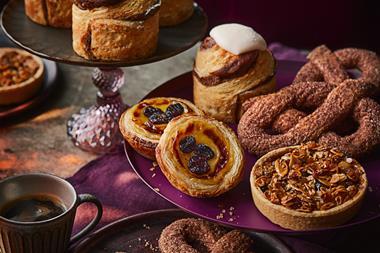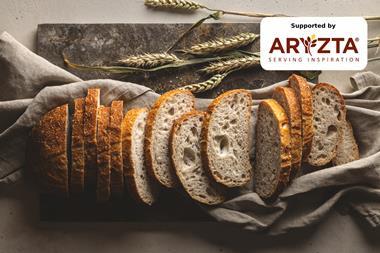As interest in global cuisines continues to grow in the UK, can breads from the Middle East and Africa gain traction with British consumers?
Bread, brood, bröt or pane – whatever it’s called, bread is present across the globe. It takes many forms, from pillowy white loaves to flexible flatbreads, dark rye and everything in between.
Despite this, flour-based fare doesn’t always translate from one culture to another. So, when it comes to the British Isles, why are some able to bridge the gap, while others get lost in translation? And, which ones are primed to find an audience on these shores in the near future?
As the nation’s culinary adventures continue, many are looking to the growing trend of Middle Eastern and African foods for inspiration. “Continuing from last year, 2019 looks to be inspired by flavours from across North Africa, the Middle East and India,” explains Paul Maxwell, marketing manager UK, Aryzta Food Solutions.
“The mixture of warming spicy and citrus notes works well with many ingredients.”
African breads tick a lot of boxes for UK foodies as they’re often made with on-trend grains such as teff, millet and cornmeal, while flatbread options can also provide a lighter bite. However, there is an education process to undergo both for bakers and consumers before the likes of injera, Eritrean hembesha, mealie bread or sweet bread (see box out p41) are commonplace.
“African breads can be baked, steamed, cooked on a griddle, or deep-fried, and are often large in size for tearing, sharing, scooping and dipping,” notes Tasneem Alonzo, joint managing director, EHL Ingredients. “It can be used instead of a utensil and is a key component of a meal.”
While British consumers might not forgo their knives and forks for flatbread, “tying a bread product with a meal is likely to resonate,” says Amy Price, senior food & drink analyst at Mintel.
But unlike naan or garlic bread, some of these breads can suffer from the lack of well-known meals they can be served alongside, hindering their take-up, she adds.
London-based Ghanaian business Uncle John’s Bakery says it has struggled when it comes to encouraging people to try something new, although it recently secured listings in Morrisons. The bakery serves up a range of traditional Ghanaian items such as sweet bread – made with sweet spices and a touch of vanilla – and traditional white loaf butter bread.
“Serving such niche products has its shortcomings, as we have experienced difficulty in gaining interest from wider communities,” says Samuel Mensah, director, Uncle John’s Bakery.
Education is needed to help those unfamiliar with the loaves to understand the traditions behind them, how they are made and how to enjoy them, he adds.
Pairing familiar breads with flavours from the region may be a better option. “You don’t have to be 100% traditional,” says Alex Dome, development chef, Food Innovation Solutions. “Take a dough and mix it with flavours such as preserved lemons, apricots and Middle Eastern spices.”
Tesco has already taken advantage of this with a Harissa Pitta, seasoned with spices and red bell pepper, and a Tesco Finest Ras El Hanout Flatbread.
Dome also sees an opportunity for Jerusalem bagels (pictured on p39), which share a name with their New York cousins but aren’t boiled, resulting in a fluffier, airier product. These are often dipped in dry spices such as za’atar or topped with sesame seeds, which Dome notes is common practice. “In Tel Aviv, a lot of the bakers’ doughs are plain, then they load them with toppings,” he says.
EHL Ingredients’ Alonzo concludes: “It’s important for bakers to experiment with recipes, flours and quantities of spices to recreate authentic flavours.”
Gallery: African breads
Injera bread
This Ethiopian sourdough flatbread is traditionally made from indigenous teff flour and is described as slightly sour and sweet in taste. Similar to a crêpe in texture, injera bread is rolled up into tubes and often used in place of a utensil or plate.
Mealie bread
A staple in South Africa and Mozambique, mealie bread is a sweetened bread baked with creamed corn. It is traditionally made by steaming rather than baking, resulting in a moist, dense bread. More recently, some bakers are adding flour and baking it.
Eritrean hembesha
This East African bread is fragrant, soft and earthy with flavours of garlic, coriander, cardamom, and fenugreek. It’s slightly sweet and is traditionally served in the afternoon with tea, drizzled with honey or spiced ghee but can also accompany stews or scrambled eggs.
Bunny chow
This South African dish (also pictured on this issue’s cover) features a hollowed out half-loaf of usually white bread, filled with a hot and spicy curry. It’s a treasured street food of South Africa and one that could be popular in the UK’s food markets and in informal dining outlets.
Source: EHL Ingredients
Why flour temperature is a hot topic for bakers
Dough temperature is key to the quality and consistency of bread – and flour temperature plays a big role in this.
If flour is kept at high temperatures for extended periods of time, the functionality of the gluten proteins may be affected and this will impact end-product quality.
“Generally speaking, to have a consistent process throughout the year, the temperature of the dough needs to be stable. For some products, such as croissants and puff pastry crackers, for example, it is very important to keep the dough temperature low,” says Silvia Dall’Agata of storage systems supplier Cepi. The company produces a flour cooling system that permeates pre-cooled, de-humidified, turbulent air through flour.
“Flour temperature directly affects the dough temperature achieved at the end of mixing” explains Clothilde Baker, Campden BRI section manager for cereals and ingredients characterisation.
“If dough temperature is too low, which might be caused by low flour temperature, the dough will be too tight and take longer to prove,” she adds. “If the converse happens, the dough will be too soft and sticky, and will not process correctly. Either situation can result in bread of inferior quality.”
Variations in flour temperature have to be accommodated by adjusting the recipe water temperature, which can be a problem for bakeries requiring chilled water, particularly in the summer when the temperature of the mains water supply may be too high for dough-making.
“There are occasions, even in this country, when flour temperatures are so high that chilled water and ice together may be inadequate because the supply cannot cope with the production,” says Stan Cauvain, co-founder of bakery consultancy Baketran.
He advises that one way of dealing with the issue is to avoid the flour delivered from the mill being warmed as it stands waiting to be used.
“External flour silos are common and need to be designed and located to limit the amount of heat that will be absorbed and transmitted to the flour,” Cauvain suggests.
But production issues aren’t the only reason to take flour storage seriously, as it can also prevent microbiological or chemical deterioration – the usable shelf-life of wheat or flour will reduce if storage temperatures are too high.


























No comments yet